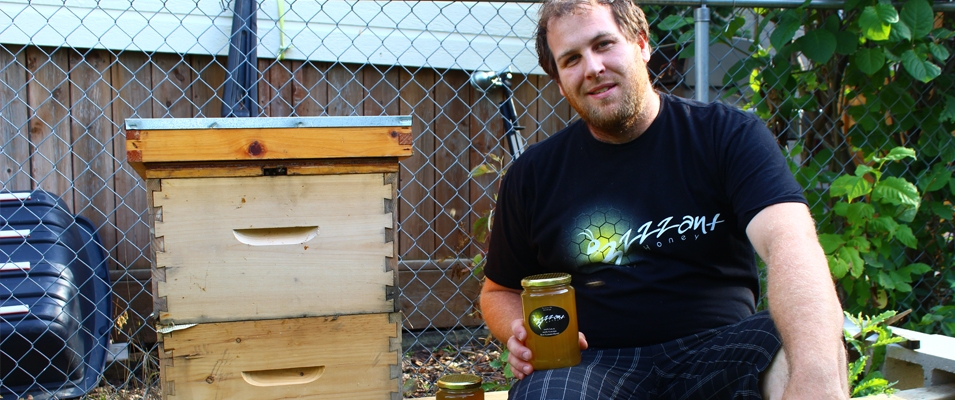
Scott and Meghan Beasant of Niverville know bees. They know the little honey-producers so well, in fact, that they’ve collaborated in business with them to create Bzzzant Honey.
“I’m a small-time [beekeeper],” says Scott Beasant. “I make a bit of profit, but it’s just covering the expenses, mostly. I hope to make a bit more in the future, but for right now the honey I’m making is finally starting to surpass the amount of money I’m spending.”
Beasant works a full-time job as a refrigerant technician with JWH. The beekeeping and honey production was initially intended to be a hobby, giving his family the perk of a low-cost sweetener. He admits that he is completely self-taught in the delicate and complicated profession of beekeeping.
“Originally, I thought maybe I’d just have a hive for [my own use],” Beasant says. “Something to have some fun.”
As his skills grew, so did his hives, and today he keeps ten hives on a rural property just north of Niverville. With increased production came sales to locals looking for fresh honey. Now Meghan is involved with managing their social media sites and YouTube pages. Even their young son gets involved, helping with the bees while donning his very own peewee bee suit.
One hive, for Beasant, consists of approximately 30,000 bees. As he learns, he’s gotten to know his bee livestock well enough to be able to tell if the hive has a strong queen bee, based on her winter survival ability, and if any new queen bees have been produced in the hive, allowing him to start another hive.
“I’m artificially driving them for a higher population, sort of like livestock,” Beasant says. “In the spring, I take weak hives and I pull resources from powerful hives and use them to bolster populations in weaker ones.”
He’s also captured bee swarms, a condition that occurs when a hive becomes overpopulated. The swarms are tightly balled groupings of bees sometimes found on tree branches or fences with a new queen bee tucked safely at its centre. Swarms like this indicate a new colony relocating to a hive of its own.
For the most part, he says, honeybees aren’t aggressive by nature but they don’t appreciate their hive being tampered with. For this reason, the best time to check a hive is during the day when the majority of the bee population has left to scout for food sources. Because his beekeeping happens mostly in the evenings, he’s had to be more careful while the population is returning home.
“If a honeybee comes up to you and starts bumping into you, they’re actually being aggressive,” says Beasant. “They don’t want to sting you because if it stings you it dies. At first it will just start bumping into you and telling you to go away.”
There are a variety of reasons Beasant needs to tamper with the hive. Every spring and fall he adds sugar water and pollen patties to the hive. In spring, this awakens them from their winter dormancy and gets them active again for a new season of productivity. In fall, it encourages them to make stores of honey that will keep them fed throughout the winter months.
During the summer months, Beasant checks his hives regularly, removing frames as they become filled with honey and replacing them with clean new frames. The full frames are taken to an outbuilding where his equipment waits.
With a special knife, Beasant scrapes the beeswax away from the frame’s surface, revealing hundreds of tiny cells, all holding miniature stores of honey. The wax is also a by-product made by the bees, used to seal each cell so that the flower nectar stored within the cells can dry and crystallize into honey.
From here the frames are placed into an extractor, a large stainless-steel drum with a manual crank. As the frames spin within this unit, the honey is released and sticks to the walls of the drum. A spigot near the bottom of the drum allows the honey to pour through filters and into a large vat. Finally, the honey is jarred and ready for use.
One of the biggest threats to a beekeeper’s livestock is overwintering. While bees are conditioned to weather a Manitoba winter, extended winters like this past one are hardest on a bee population.
Beasant saw a 72 percent loss to his stock this year. He went into last fall with 14 hives and by spring only four had survived.
“If they’re stuffed in the hive for too long, they start getting dysentery and all kinds of things,” Beasant says. “Normally my bees are outside by March, getting some fresh air and defecating outside the hive.”
Beasant explains that a reduction in flower pollen and nectar in fall indicates that winter is coming. As temperatures drop, the bees form a tight huddle around their queen, who always remains at the core.
The bees vibrate to add warmth to the hive, and rotate like a convection current, the inner bees moving to the outside of the ball, allowing the outer bees a chance to move inward for warmth. The colder it gets, the less they vibrate, conserving energy for the toughest winter months. Eventually, the outer bees begin to die off if the spring temperatures don’t arrive early enough.
“You have attrition occurring on the outside of the ball,” Beasant says. “When you have a long cold winter, that ball gets smaller and smaller and the amount of heat drops and drops. Going into March, I had about nine hives, but by the end of the month I was down to five because the extended length of the winter is just too much.”
For this reason, Beasant puts entrance reducers on the hives in fall to help keep the heat in. He also wants to experiment with placing his homemade insulation pads on the outside of the hives this coming winter.
In spite of the winter losses, the hives that do manage to winter through are the powerful ones, proofed by their survival. Powerful hives are strong producers of healthy new populations.
While it’s amazing to consider the bee’s ability to create something as delectable as honey, what’s equally fascinating and awe-inspiring is the lifecycle of a hive and the powerhouse at the centre of that hive: the queen.
“The queen doesn’t do anything but lay eggs,” says Beasant. “She doesn’t even feed herself or [leave the hive to] defecate. The [worker bees] actually take the faeces from her and escort it out of the hive. All she cares about is laying as many eggs as possible. She goes to every cell and measures the cells with her little mandibles, making sure it’s the right kind of cell, because male eggs are bigger.”
The queen lays up to 3,000 eggs per day from spring through fall. These eggs hatch within 21 days. Her primary goal is to ramp up production by adding bee numbers during the peak months. She has complete control of the kind of eggs she lays, whether they are male, female, or future queen bees. The majority of eggs she’ll choose to lay are female since they are the only worker bees in the colony. Males are only good for reproduction, so few are actually needed in the function of the hive.
“She will only lay the male eggs once enough nectar has come in because they are a waste of resources,” Beasant says. “They don’t help at all. They don’t even have a stinger, they just have genitals. They don’t even protect the hive.”
Bees born during the summer months have a five-week lifecycle. After birth, their first job is that of housekeeping: taking out the trash such as dead bees, tending the young, feeding the queen, and cleaning and lining the cells with an antibacterial sap they gather from trees to ready the cells for new eggs.
From here they graduate to field bees, leaving the hive slowly at first to take orientation flights within close proximity of the hive. This ensures that they will recognize their surroundings adequately to return every day.
“It’s flight school,” Beasant quips. “You’ll see them flying in circles around the hive and over the course of time they’ll start to go farther and farther.”
Once ready for field trips, bees are given instructions from the top down. Some will be commissioned to collect nectar, others pollen which will feed the larvae their daily dose of protein. According to Beasant, they will never deviate from their duty and risk disappointing the queen, who governs the entire brood.
In fall, it’s the queen who decides when to shut down production of new eggs.
“When the temperature starts falling, she’ll start slowing down brood production so there’s less bees in the hive,” Beasant says. “This way, she’s not feeding all these bees in the winter. It’s about ramping down soon enough while trying to [keep a sufficient] population for next summer.”
At times, when the colony shows signs of outgrowing the hive, the queen will lay new queen eggs to encourage the formation of a new colony which will separate from her own.
While she may lay several queen bee eggs, only one will survive. The first queen infant to exit her cell will lance the openings of all other queen bee cells, causing them to die.
The queen also gives off pheromones that are unique to her. As her colony rubs shoulders with her, the chemical is transferred to each bee, allowing them to identify as her colony. This makes for easy identification of outsider bees that attempt infiltration. Unless they come bearing a sack of nectar like a gift, they are quickly ushered off.
Beasant says he’ll get approximately 1,000 pounds of honey from his hives this summer. That’s about double what he made last summer. Many of his clients are return customers, placing large orders for their annual use. He welcomes new customers, too, at least until his stock is depleted for one more season.




















